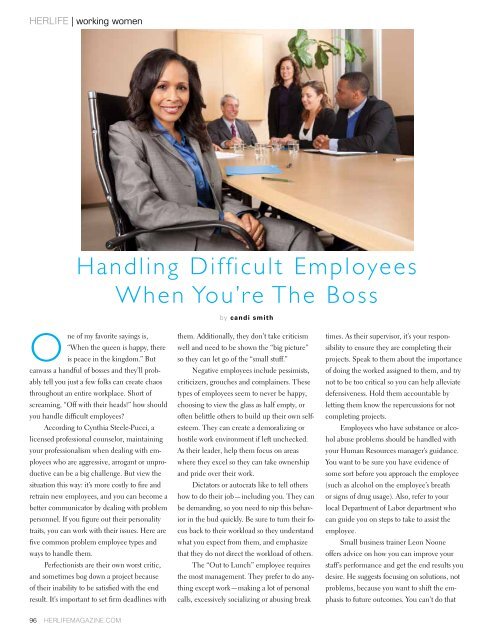Create successful ePaper yourself
Turn your PDF publications into a flip-book with our unique Google optimized e-Paper software.
herlife | working womenHandling Difficult EmployeesWhen You’re The Bossby candi smithOne of my favorite sayings is,“When the queen is happy, thereis peace in the kingdom.” Butcanvass a handful of bosses and they’ll probablytell you just a few folks can create chaosthroughout an entire workplace. Short ofscreaming, “Off with their heads!” how shouldyou handle difficult employees?According to Cynthia Steele-Pucci, alicensed professional counselor, maintainingyour professionalism when dealing with employeeswho are aggressive, arrogant or unproductivecan be a big challenge. But view thesituation this way: it’s more costly to fire andretrain new employees, and you can become abetter communicator by dealing with problempersonnel. If you figure out their personalitytraits, you can work with their issues. Here arefive common problem employee types andways to handle them.Perfectionists are their own worst critic,and sometimes bog down a project becauseof their inability to be satisfied with the endresult. It’s important to set firm deadlines withthem. Additionally, they don’t take criticismwell and need to be shown the “big picture”so they can let go of the “small stuff.”Negative employees include pessimists,criticizers, grouches and complainers. Thesetypes of employees seem to never be happy,choosing to view the glass as half empty, oroften belittle others to build up their own selfesteem.They can create a demoralizing orhostile work environment if left unchecked.As their leader, help them focus on areaswhere they excel so they can take ownershipand pride over their work.Dictators or autocrats like to tell othershow to do their job—including you. They canbe demanding, so you need to nip this behaviorin the bud quickly. Be sure to turn their focusback to their workload so they understandwhat you expect from them, and emphasizethat they do not direct the workload of others.The “Out to Lunch” employee requiresthe most management. They prefer to do anythingexcept work—making a lot of personalcalls, excessively socializing or abusing breaktimes. As their supervisor, it’s your responsibilityto ensure they are completing theirprojects. Speak to them about the importanceof doing the worked assigned to them, and trynot to be too critical so you can help alleviatedefensiveness. Hold them accountable byletting them know the repercussions for notcompleting projects.Employees who have substance or alcoholabuse problems should be handled withyour Human Resources manager’s guidance.You want to be sure you have evidence ofsome sort before you approach the employee(such as alcohol on the employee’s breathor signs of drug usage). Also, refer to yourlocal Department of Labor department whocan guide you on steps to take to assist theemployee.Small business trainer Leon Nooneoffers advice on how you can improve yourstaff’s performance and get the end results youdesire. He suggests focusing on solutions, notproblems, because you want to shift the emphasisto future outcomes. You can’t do that96 <strong>HERLIFE</strong>MAGAZINE.COM
















